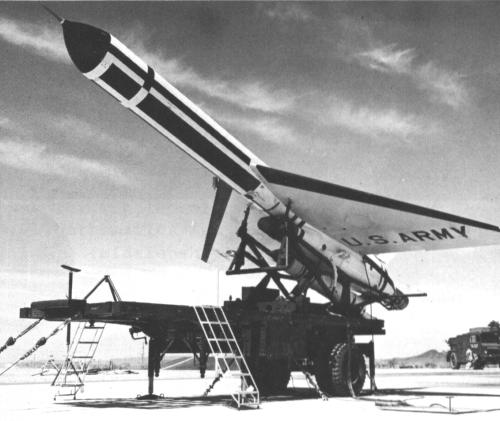Fairchild SD-5 Osprey
In 1958, Fairchild received a U.S. Army contract to develop a jet-powered surveillance drone for the AN/USD-5 drone surveillance system. The drone itself, named Osprey, was referred to either as SD-5 or also as AN/USD-5, although the latter was more properly the designation of the whole system. The Osprey first flew in May 1960.
 |
| Photo: U.S. Army |
| SD-5 |
The SD-5 was a subsonic delta-wing aircraft powered by a single Pratt & Whitney J60 turbojet. It was zero-length launched with the help of a single solid-propellant rocket booster (giving 178 kN (40000 lb) of thrust for 3 sec) and recovered by parachute. The drone had an operational radius of 1600 km (1000 miles) and could fly at altitudes between a few hundred feet and 10700 m (35000 ft). Projected payloads were infrared scanners, side-looking radar and optical mapping systems. The sensor data could either be transmitted by radio or stored for examination after drone recovery.
The Army had planned to have the AN/USD-5 system operational by 1964. However, in November 1962 the program was cancelled because of budget constraints.
Specifications
Note: Data given by several sources show slight variations. Figures given below may therefore be inaccurate!
Data for SD-5:
| Length | 11 m (36 ft) |
| Wingspan | 7.3 m (24 ft) |
| Height | 2.4 m (8 ft) |
| Weight | 4000 kg (9000 lb) |
| Speed | Mach 0.7 |
| Ceiling | 10700 m (35000 ft) |
| Range | 1600 km (1000 miles) |
| Propulsion | Pratt & Whitney J60 turbojet; 13.3 kN (3000 lb) |
Main Sources
[1] Kent A. Mitchell: "Fairchild Aircraft 1926-1987", Narkiewicz/Thompson, 1997
[2] Norman J. Bowman: "The Handbook of Rockets and Guided Missiles", Perastadion Press, 1963
Back to Directory of U.S. Military Rockets and Missiles, Appendix 4
Last Updated: 5 May 2004